Research Progress on Bacteriostasis of Nano Selenium
2021-06-30LihongWANGHuiYANGYangKONGXutaoSUN
Lihong WANG, Hui YANG, Yang KONG, Xutao SUN
School of Food and Biological Engineering, Shaanxi University of Science & Technology, Xi’an 710021, China
Abstract Nano selenium which has the advantages of low toxicity, strong activity and high biocompatibility has broad-spectrum antibacterial activity to bacteria, fungi, viruses and parasites, and has a broad application prospect in the field of inhibiting microbial infection. This paper mainly reviews the progress in the types and mechanisms of selenium inhibition microorganisms, and prospects the development of the antibacterial activities of selenium nanoparticles.
Key words Nano-selenium, Bacteriostasis, Microorganism, Mechanism
1 Introduction
With the overdoses of antibiotics, the drug resistance of pathogens is becoming more and more common and poses a serious threat to public health. In order to inhibit drug-resistant bacteria, the effective measures are to increase the dosage of drugs and prolong the time of drug use, but at the same time, the toxicity to the body increases, eventually leading to the increase of mortality. Therefore, the development of non-toxic and efficient antimicrobial drugs is a hot topic in the current research.
Nanoparticles with the characteristics of small volume and large specific surface area easy to anchor on the cell wall, penetrate and destroy the cell wall and cell membrane structure, and finally lead to the increase of cell membrane permeability and cell death. Moreover, nano materials have strong adsorption capacity and high biocompatibility, which can be used as drug carriers. At present, more and more nanodrugs have been used in antibacterial research and treatment. The antibacterial materials represented by silver nanoparticle (SNP) have been applied in food packaging, medical catheter and wound dressing fields, but the toxicity of silver nanoparticles limits their wide application.
Selenium (Se) is a necessary microelement in organism, and is a cofactor for many proteins and enzymes in human body. It has important physiological functions in improving immunity, antioxidation, regulating metabolism, detoxification and promoting reproduction of organism. Selenium in nature mainly exists in the equivalent states of +VI, +IV, 0 and -II. Zero-price elemental selenium (Se) is generally black and gray, non-toxic but also not biologically active, and can not be used by organisms. From research, selenium nanoparticles (SeNPs), when Seis in the nanometer level, have unique physical and chemical properties, such as strong physical and chemical activity, high bioavailability and low toxicity, and have important application value.
In recent years, the application of SeNPs in antibacterial has been widely studied. Different from antibiotics, SeNPs have broad-spectrum antibacterial activity against bacteria, fungi, viruses and parasites, so they are expected to be an alternative product to antibiotics. This paper reviews the research progress in recent years from the aspects of the types and mechanisms of the inhibition of SeNPs, laying a foundation for the application of nano selenium in inhibiting microbial infections.
2 Types of microorganisms inhibited by SeNPs
2.1 Bacteria
The inhibition of SeNPs on bacteria is the most widely studied, mainly for common clinical pathogens such asEscherichia
coli
,Staphylococcus
aureus
,Pseudomonas
aeruginosa
,Streptococcus
pyogenes
,Vibrio
harveyi
, andSalmonella
typhimurium
. In the inhibition of bacterial infection, SeNPs can directly inhibit bacteria, also can be used in combination with other drugs, and have inhibitory effect on biofilm formation.2.1.1
Antibacterial effect of SeNPs. SeNPs have inhibitory effect on both gram negative and gram positive bacteria, as shown in Fig.1, and they affect the growth and reproduction of bacteria. The minimum inhibitory concentration (MIC) is 1-200 ppm. Wanget
al.
reported that the effect of SeNPs on negative bacteria is slightly stronger. The possible reason is that the antibacterial activity of SeNPs is related to the particle size and antibacterial mechanism. The smaller the particle is, the easier it is to pass through the cell wall and enter the cells. The polysaccharide layer of the cell wall of gram positive bacteria is thicker, so the large nanoparticles are not easy to penetrate into the cells. Therefore, when SeNPs are used for gram positive bacteria, the nano size is particularly critical, and the smaller the particle is, the stronger the antibacterial effect is. Huanget
al.
synthesized SeNPs with different sizes (43-205 nm) and studied the antibacterial activity. The antibacterial effect results showed that SeNPs with size of 81 nm had the maximum growth inhibition and inactivation effect onS.
aureus
and methicillin resistantS.
aureus
(MRSA), and the minimum inhibitory concentration was (16±7) ppm. Moreover, the smaller the particle size, the larger the specific surface area, which is conducive to the contact between SeNPs and microbial cells, improving the antibacterial activity. SeNPs can also be added to materials for antibacterial. Liuet
al.
synthesized titanium nanotubes doped with SeNPs, which had significant inhibitory effect on the growth ofE.
coli
andS.
aureus
. Yipet
al.
applied selenium nanoparticles modified by polysaccharide-protein complexes (PSP-SeNPs) onto fabric, and found that they effectively inhibited the growth of fungi and bacteria.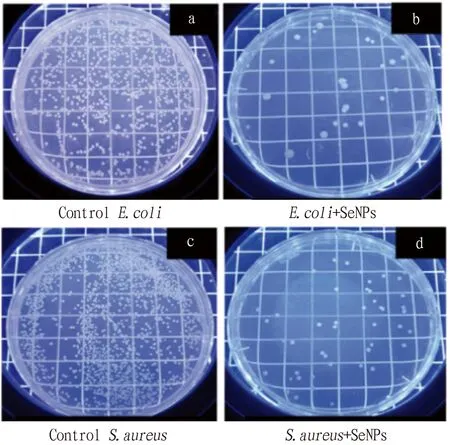
Fig.1 Antimicrobial plate images of Escherichia coli (a) and Staphylococcus aureus (c) control colonies and colonies treated with SeNPs + Escherichia coli (b) and SeNPs + Staphylococcus aureus (d)
2.1.2
Combination of nano selenium. Nano materials have large specific surface area, and can be prepared into porous, hollow, multilayer and other structures. Combining drugs with load antibacterial drugs can significantly enhance the antibacterial ability of nano selenium while reducing toxicity. If targeted drug is modified with nano-selenium particles on the surface, the drug can be targeted and sustained-release, and kill most of the multidrug-resistant bacteria. Huang Xiaoquanused quercetin and acetylcholine chloride to modify nano selenium (Qu-Ach@Se), as shown in Fig.2. The results showed that acetylcholine bound to the receptors on the cell surface, effectively promoted the antibacterial activity of nano selenium and killed multidrug-resistant superbacteria.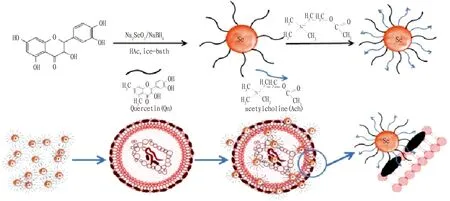
Fig.2 Schematic illustration of the synthesis of Qu-Ach@SeNPs and action on the target bacteria
2.1.3
Anti biofilm effect of nano selenium. Biofilm is a kind of closed and fixed microbial community, attached to the nonbiological and biological surfaces, and has functions of protecting the microorganism from the adverse environment and improving its survival capacity. Biofilm formed by pathogenic bacteria is the barrier of antibacterial drugs, and prevents drugs from penetrating into the cell, so many antibiotics are difficult to play a role, resulting in persistent infection. Nanoparticles have higher penetration ability than drug particles, and are still effective for bacteria easy to form biofilm.The microbial colonization and biofilm formation on medical devices are the common problems that cause hospital infection, which not only affects the critical patients and the patients with impaired immune function, but also leads to equipment failure. SeNPs can effectively inhibit microbial colonization on the surface of equipment by reducing bacterial adhesion mediated protein. SeNPs coating is expected to fundamentally solve the problem of biofilm formation on the surface of medical devices. Sonkusreet
al.
used the SeNPs synthesized byBacillus
licheniformis
JS2 to resist biofilm formation by inhibiting the adhesion and colony formation ofS.
aureus
on the surface of glass, polystyrene and epoxy resin. Keskinet
al.
found that mixing SeNPs on the material could inhibit the formation ofP.
aeruginosa
biofilm, and had no side effects on healthy cells. Cell adhesion and cell compatibility experiments showed that SeNPs were helpful to the growth and adhesion of cells. Therefore, as a new antibacterial coating, nano selenium has a broad application prospect in medical equipment.2.2 Fungi
At present, the research on the inhibition of SeNPs on fungi mainly focuses on the prevention and control of pathogenic fungi infection in crops. According to the estimation of Food and Agriculture Organization (FAO), fungal infection causes 25% of the loss of agricultural products in the world, which is the main threat to agricultural production. SeNPs showed inhibitory effect onFusarium
oxysporium
Schl,Mycosphaerella
fragariae
,Pestalotiopsis
clavispora
,Magnaporthe
oryzae
andStreptomyces
. However, there are differences in the inhibition strength of SeNPs on different plant pathogens. Zhu Yanyunet
al.
found that the inhibition activity of SeNPs onF.
oxysporium
Schl andP.
clavispora
was significantly better than that onM.
fragariae
, which was mainly related to the different ways of selenium metabolism by fungi. The weak inhibition ability to some fungi may be due to the fact that the strains use SeNPs as a nutrient to educe the toxicity through the metabolic process.SeNPs inhibit different stages of fungi from spore germination to hyphae growth, and show a dose-dependent effect. Zhou Chistudied the inhibitory effect of different concentrations of SeNPs (0, 50, 100, 150 and 200 μg/mL) onM.
oryzae
, as shown in Fig.3. The results showed that SeNPs had a good inhibitory effect onM.
oryzae
. With the increase of SeNPs concentration, the inhibitory effect on the colony growth of pathogenic fungi became stronger. The inhibition of SeNPs on spores was mainly manifested in inhibiting spore formation, and combination with zoospores, which inhibited the fungal spore infection from the root source.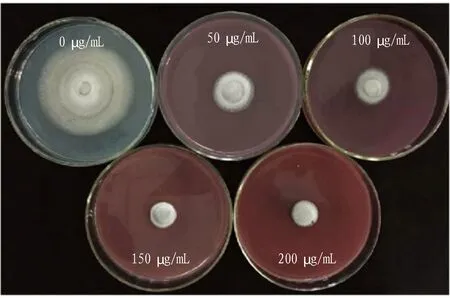
Fig.3 Effect of nano-selenium on the growth of Magnaporthe oryzae
SeNPs can also inhibit the formation of fungal biofilm. Guisbierset
al.
reported that SeNPs are easy to adhere to the biofilm and penetrate into the cell, enabling them to inhibit the formation ofCandida
albicans
biofilm by destroying the cell structure.2.3 Virus
Selenium is helpful to improving the body’s resistance to virus and fighting against virus infection. Compared with selenium deficient mice, the mortality of mice injected with inorganic selenium NaSeOdecreased three times, and the levels of TNF-α and IFN-γ increased. SeNPs are more safe than inorganic selenium, so they have attracted people’s attention in anti-virus. Liet
al.
combined oseltamivir (OTV) with nano selenium (Se@OTV), and through the inhibition of the activity of influenza virus glycoprotein hemagglutinin and neuraminidase by OTV, and the inhibition of reactive oxygen species production, p53 phosphorylation and Akt activation by SeNPs, the H1N1 infection of canine kidney cells was effectively prevented. Therefore, SeNPs are expected to be used in the treatment of highly infectious respiratory diseases caused by influenza A virus H1N1.It was found that selenium deficiency was related to the positive results of COVID-19 patients. In the face of global COVID-19, nano selenium is playing an important role in the struggle against COVID-19.
2.4 Parasites
At present, there are few reports about the inhibition of nano selenium on parasites. Yazhiprabhaet
al.
found that SeNPs had significant larvicidal activity against the 4instar larvae ofAedes
aegypti
, which caused dengue fever. Beheshtiet
al.
studied the inhibitory effect of selenium nanoparticles onLeishmania
major
(MRHO/IR/75/ER), and concluded they can be used as a new bioactive for the treatment of cutaneous leishmaniasis.3 Bacteriostatic mechanism
Nano selenium and antibiotics have different antibacterial mechanisms. Antibiotics generally inhibit the growth of bacteria by inhibiting the synthesis of protein, cell wall, DNA and other biomolecules. By attaching to the cell surface and inserting into the cell wall or cell membrane, SeNPs produce nano perforation and cause the leakage of intracellular substances. Then selenium factor is released into bacteria cells to induce reactive oxygen species (ROS) production, DNA degradation and ATP consumption, resulting in continuous damage from outside to inside.
3.1 Destruction of cell integrity
SeNPs can destroy the integrity of cell wall or cell membrane, leading to the outflow of intracellular components, and then cause the death of bacteria. The membrane perforation caused by nanoparticles on cell wall and membrane is similar to nanoknife technology in medical treatment. Due to the Hall-Petch effect, the small-size nanop-articles have high resistance to dislocations in the crystal, which leads to high toughness and hardness in the interface mechanical properties. When small-sized nanoparticles are adsorbed on the surface of the membrane, the particles with high hardness produce continuous shear force on the adsorption sites, and eventually cause damage to the cell membrane or cell wall. Therefore, the perforation effect of nanoknife is related to the size and morphology of nanoparticles, and the perforation ability is more prominent when the particle size is less than 20 nm. In the antibacterial research of SeNPs, most sensitive bacteria produce morphological changes. Liet
al.
observed the morphological changes ofE.
coli
andS.
aureus
treated with SeNPs by scanning electron microscope (SEM) and transmission electron microscope (TEM). The control group had regular shape, and the cell wall was smooth and round, while the SeNPs treatment group had different degrees of morphological changes, such as depression or damage of cell wall, separation of plasma wall, and certain damage of cell membrane. Al-saggafet
al.
studied the morphological changes ofS.
typhimurium
andE.
coli
treated with SeNPs at different times, as shown in Fig.4. At 0 h, the cells of the two bacteria were smooth. After 5 h, nano selenium attached to the cell wall and the bacterial cells expanded. After 10 h, the number of SeNPs increased, the cell morphology was obviously bent and deformed, and the contents were released.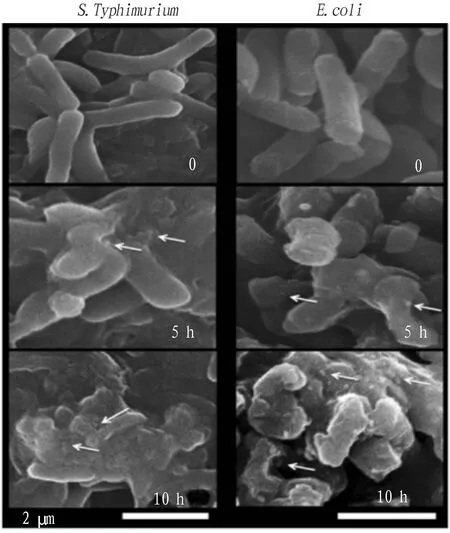
Note: Arrows indicate some attached SeNPs to compromised bacterial cells.
3.2 Induced reactive oxygen species
Reactive oxygen species (ROS) are products of oxygen reduction in the body, including superoxide free radical (O), singlet oxygen (O), hydroxyl free radical (·OH) and hydrogen peroxide(HO). The formation of ROS can induce cell damage and apoptosis. Nanoparticles have oxidase-like activity, and can easily combine with oxygen and promote the dissociation of O, thus catalyzing the production of ROS. The formation of ROS was observed when SeNPs were applied to microorganisms. Huang XiaoquantreatedE.
coli
andS.
aureus
with Qu-Ach@SeNPs, and the results showed there was a significant increase in ROS in the cells and the antibacterial activity of Qu-Ach@SeNPs was related to the generation of ROS. Moreover, the smaller the particle size, the stronger the ability to induce ROS.At the same time, it is safe for human cells that nano selenium induces the formation of ROS. Cremoniniused SeNPs to inhibitP.
aeruginosa
in the culture of human dendritic cells and fibroblasts, and no increase in the release of ROS from human cells was observed, indicating that SeNPs only acted on bacteria and induced ROS formation. Moreover, in cells infected by virus, SeNPs can also reduce the concentration of ROS. The production of ROS increased from 100% to 380% in H1N1 infected cells, while the concentration of ROS was significantly reduced (120%) by Se@OTV.3.3 Destruction of DNA structure
SeNPs can also induce apoptosis by breaking the structure of DNA. Beheshtiet
al.
studied the DNA structure changes ofL.
major
(MRHO/IR/75/ER) promastigotes treated with nano selenium for 24 h, as shown in Fig.5. Under different concentrations of SeNPs (0, 1, 50 and 150 g/mL), the DNA fragment size of promastigotes ranged from 100 to 1 000 base pairs (2-4 channels), and the DNA fragment was broken into fragments, while no obvious DNA fragment was observed in the control group (channel 1).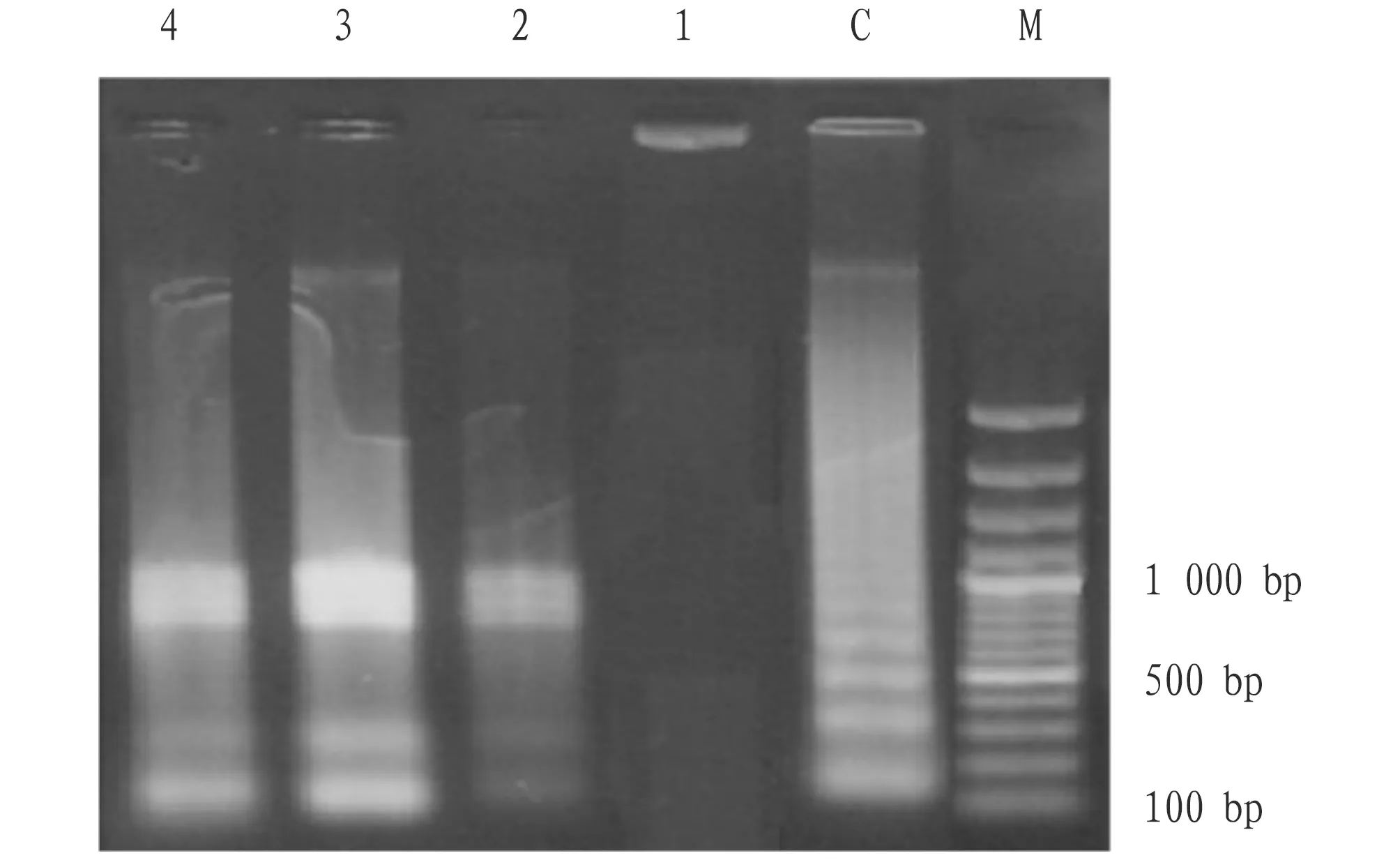
Note: Lane M: size marker; Lane C: positive control from the kit; Lanes 2-4: fragmentation in genomic DNA of promastigotes; Lane 1∶0 g/mL; Lane 2∶1 g/mL; Lane 3∶50 g/mL; Lane 4∶150 g/mL.
3.4 Consumption of ATP between cells
ATP is the energy supplier of many enzyme reactions in cell respiration and metabolism, and plays a crucial role in organism. SeNPs can inhibit the respiration metabolism of bacteria by consuming ATP in cells, and lead to the loss of cell vitality to achieve bacteriostatic effect. Huanget
al.
studied the effect of SeNPs on the ATP level ofS.
aureus
. The results showed that the ATP ofS.
aureus
treated with SeNPs decreased significantly.4 Outlook
Nano selenium has good antibacterial properties on bacteria, fungi, viruses and parasites by influencing cell structure, inducing reactive oxygen, destroying DNA and consuming ATP. However, there are many problems in the use of nano selenium as antibacterial materials and the substitution of antibiotics. Firstly, the size effect of nano selenium, the smaller the particle, the stronger the antibacterial activity. However, the synthesis of nano selenium still has a big problem for size control, and effective control of the particle size of nano selenium is one of the important contents of future research. Secondly, the bacteriostatic mechanism of SeNPs is lack of systematic research. There are still many unsolved mysteries about the process, distribution and targets of SeNPs from the outside to the inside of the bacteria. Thirdly, the safety of SeNPs on human body and animals, what effect will they have on the organism during the antibacterial process. These problems need to be explored and studied.
杂志排行
Asian Agricultural Research的其它文章
- Comprehensive Construction of Innovative Talent Cultivating Model in Colleges and Universities
- Application of Big Data in the Remediation of Contaminated Sites
- Advances in Research on Effect of Heavy Metals Cd and Pb on Wheat and Mitigation Effect of Conditioners
- Breeding of Jingdan 15, a New Stress-resistant and High-yield Maize Cultivar
- Endogenous Governance: Governance Way and Realization Path for Construction of Chinese Characteristic Town
- Effect of Sodium Selenite-Chitosan Compound Preservative on Storability of Kumquats
